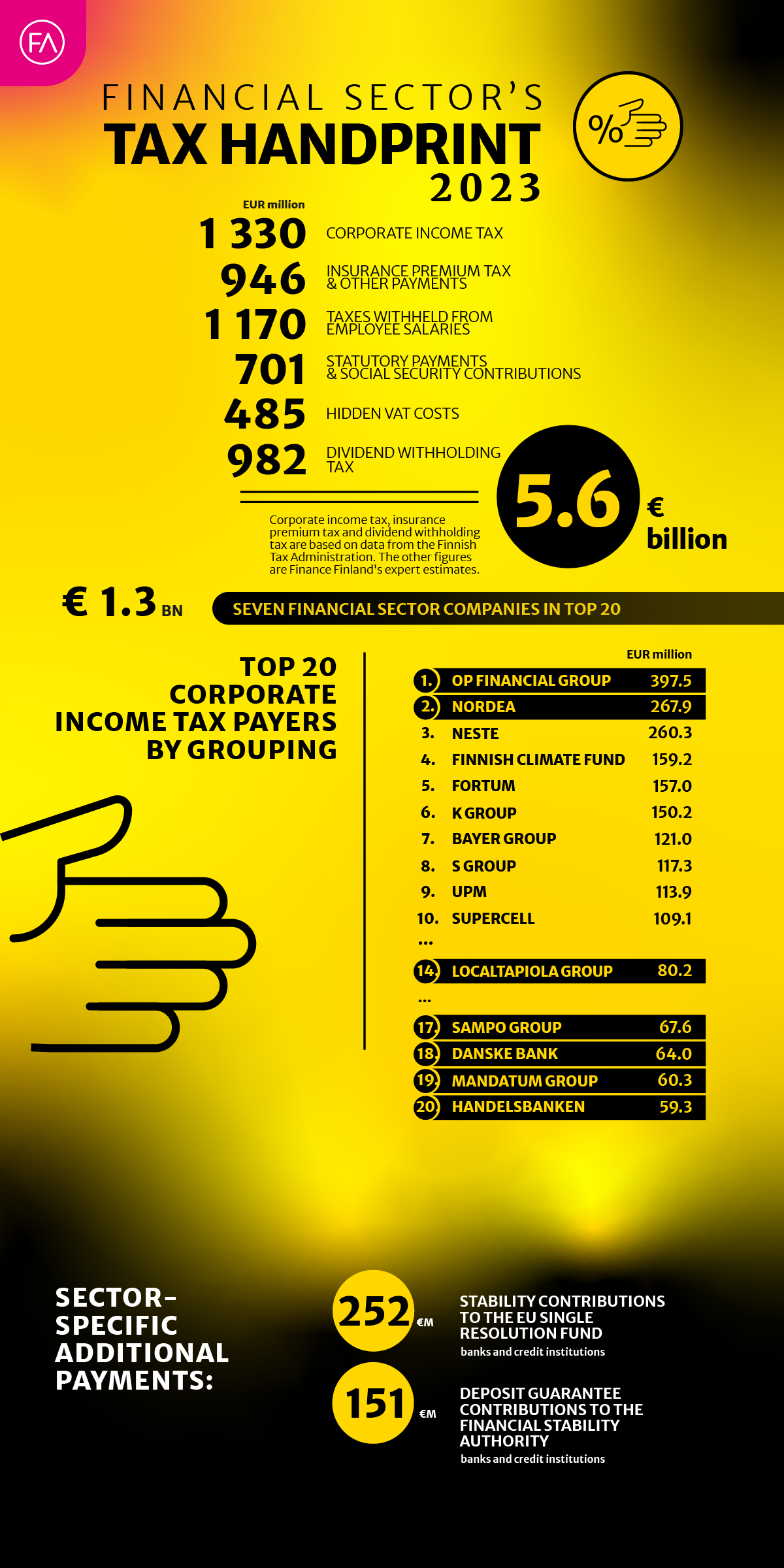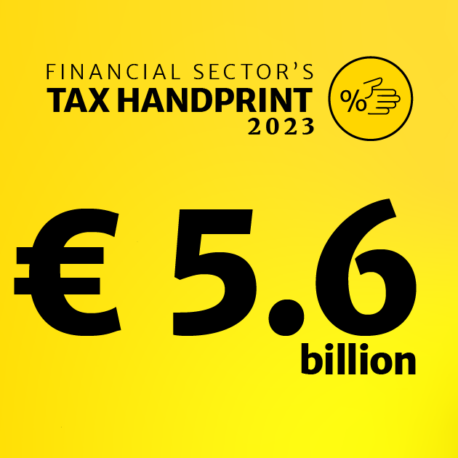
- The financial sector was once again one of the biggest taxpayers in Finland according to the 2023 tax data released by the Tax Administration.
- Financial sector companies paid €1.3 billion in corporate income tax. This amounted to 18.1% of all corporate tax in Finland. In 2022 the figure was €900 million.
- OP Financial Group and Nordea were the two biggest corporate tax payers in Finland.
- The sector’s total tax handprint grew from €5.1 billion to €5.6 billion.
The top 20 largest payers of corporate tax included seven financial sector companies. The single biggest corporate tax payer in 2023 was OP Financial Group, with Nordea placing second in the listing. The total amount of corporate income tax paid by the Finnish financial sector in 2023 was €1.3 billion.
“The figure proves that banks and insurers are among the most significant taxpayers and financiers of the Finnish welfare society. The corporate taxes paid by financial sector companies amounted to 18.1% of all corporate tax in Finland”, says Finance Finland’s CEO Arno Ahosniemi.
Finland’s total corporate income tax revenue in 2023 was €7.35 billion.
The largest corporate tax payer in Finland was OP Financial Group (€397.5 million), followed by Nordea (€267.9 million) in second place and the oil and gas giant Neste (€260.3 million) in third. The next biggest taxpayers in the financial sector were LocalTapiola Group (€80.2 million, 14th), Sampo Group (€67.6 million, 17th), Danske Bank (€64.0 million, 18th), Mandatum Group (€60.3 million, 19th) and Handelsbanken Group (€59.3 million, 20th).
Finance Finland compiled the financial sector data based on public information provided by the Finnish Tax Administration. Other sectors’ figures have also been calculated at group level.
The taxes paid by financial sector companies would cover Finland’s military defence budget
The financial sector’s total tax handprint in 2023 was €5.6 billion. The taxes paid by financial sector companies would cover Finland’s entire military expenditure: the budget allotted to military defence in 2024 is €5.4 billion.
The tax handprint for the sector is calculated from its corporate income tax (€1.3 billion), insurance premium tax (€922 million) and contributions towards fire protection, road safety and industrial safety (€24 million). The sector also generates employee income tax (€1,170 million), social security contributions (€701 million) and dividend withholding tax (€982 million), and pays hidden VAT costs of €485 million.
Finance Finland’s Ahosniemi: VAT exemption burdens the sector ‒ no solution in sight
In accordance with the EU VAT directive, financing and insurance services are exempt from value added tax. This exemption is based on difficulties in defining the tax base, problems with technical implementation and reasons of international competition.
Finance Finland has estimated that the sector’s hidden VAT burden amounts to €485 million per year.
“Unlike most companies, financial sector companies cannot deduct the VAT for the goods and services they purchase. The sector thus bears a hidden VAT burden compared to companies that sell services subject to VAT”, explains Ahosniemi.
There is no quick solution to the problem in sight. The Commission is currently reviewing the sector’s VAT treatment and considering different ways to withdraw of the VAT exemption for financial and insurance companies. This is not the first time the matter has been discussed over the years. The obstacle that has so far proven insurmountable is that it is difficult – if not altogether impossible – to define where value added is created in the financial sector. The sector also includes a very diverse range of companies, and VAT would be calculated differently depending on whether the company is a bank, an investment firm or an insurance company.
“The VAT is a consumption tax, which means the tax burden is designed to be borne by consumers. Do we really want the same to apply in financial sector services and products? Another complication is that Nordic financial sector companies are very small players in European comparison. If the tax exemption of financial companies is withdrawn, the systemic costs alone will be massive and administrative burden will only increase”, Ahosniemi explains.
Ahosniemi points out that the current system is highly fragmented and complex and by no means flawless, either. The cost-sharing systems of cross-border groups are especially cumbersome.
“It’s not an easy situation: there’s real need for a reform, but the sector has decided to wait and see what direction this reform would be taking.”
Nearly €400 million in sector-specific additional payments
In addition to the national taxes and contributions, credit institutions pay stability contributions to the EU Single Resolution Fund. In 2023, the Finnish Financial Stability Authority collected a total of €252 million in stability contributions from Finnish credit institutions. Credit institutions and banks also paid a total of €151 million in deposit guarantee contributions to the Financial Stability Authority.
The total amount of stability contributions collected from Finnish banks reaches €1.66 billion. After the contributions for 2023 were collected, the Deposit Guarantee Fund amounted to approximately €1.07 billion.
Sources used in the calculation of the sector’s tax handprint: Finnish Tax Administration, Statistics Finland, companies’ financial statements, Finance Finland.
Looking for more?
Other articles on the topic

Financial sector’s VAT treatment needs an overhaul, but the Finnish pension system must not be hampered with added tax burden

The Nordic financial sector calls for harmonised implementation of the FASTER Directive

Income taxes paid by financial sector companies grew to €1.3 billion in 2023, and the sector’s total tax handprint of €5.6 billion would cover Finland’s military expenditure – OP Financial Group and Nordea the two largest taxpayers in Finland

Finance Finland proposes ways to increase economic growth and tax revenue: Finnish law must provide for retail ELTIFs








